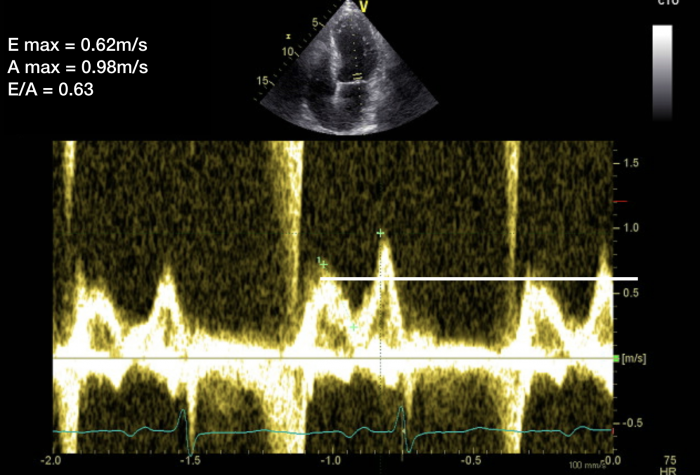The easy way of making things simple – Would you cheat?
Recently, I imaged a patient with left ventricular hypertrophy and mildly reduced LVF. I came across a mitral inflow PW Doppler image with a small E wave and a rather large A wave. The E/A ratio was 0.6.

A Jackpot?

Disappointment in the signal
But at a second look there was one problem with the signal: The E wave was 0.6ms. Just a tick away from what is required to truly put the patient into the grade I category. If you read the guidelines carefully grade I diastolic dysfunction is defined both by an E/A ratio ≤ 0.8 AND an E wave velocity ≤ 0.5ms. Just 0.1ms makes all the difference.
What would you do?
You can take it as it is and continue along the “middle” of the flow chart and evaluate three more parameters to determine if the patient has grade I (or grade II) diastolic dysfunction. Or “cheat a little and simply move the curser down a bit or wait for a beat that fits your needs (the first beat would actually make it to 0.5ms). What would you do? Well I did calculate the E/e´ratio (15), LA volume calculation (30ml/m2) but the TR velocity could not be measured. So this puts our patient into the “undetermined” category.
Cheating in science
I was reminded of an article I read some time ago about scientific fraud and cheating in research. The authors performed a survey asking about scientific conduct. Not many committed that they falsify data (2%). However when they were asked about the behavior of colleagues “fabrication, falsification and modification had been observed, on average, by over 14% of respondents. Other “questionable practices” was reported by up to 72%.”[1]
[1] Fanelli D et al, PLoS One. 2009

Doesn’t this make you think? Can we always rely on scientific data and studies? How often do we also cheat in our patients? In our example it doesn’t make much of a difference. If we “cheat” we would classify him as grade I if not he would fall into the category of “undetermined”. Most likely the patient is somewhere between grade I and II and his filling pressures are high normal or mildly elevated. It does not have an impact on the diagnosis or treatment.
The bottom line
Guidelines are important, but be aware that you will always find patients which are difficult to put into one or the other category. We will always have different shades of grey therefore we need to see the entire picture. A fraction of a milliliter, millisecond or any other value only plays a role if you are solely captured in guidelines.
My suggestion: use your experience, clinical judgment and common sense. That way you will serve your patients best.
Thomas Binder and the 123sonography Team

